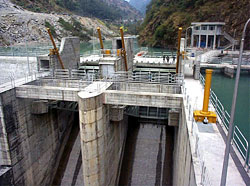 Nepal's power sector has come full circle. Bundled up into a single agency to handle generation, transmission and distribution in the 1980s at donors' behest, it is now being 'unbundled', again because of donor pressure. Will the reorganisation work this time?
Nepal's power sector has come full circle. Bundled up into a single agency to handle generation, transmission and distribution in the 1980s at donors' behest, it is now being 'unbundled', again because of donor pressure. Will the reorganisation work this time?
Draft copies of the Electricity Ordinance and the Nepal Electricity Regulation Commission Ordinance are now being reviewed at the Law Ministry. Once they are introduced the Nepal Electricity Authority (NEA) will be broken up into different entities for power generation, transmission and distribution.
"The act is being introduced basically to lure in the private sector," explains Minister of State for Water Resources Binod Kumar Shah.
On the generation side things will change little because already nearly one dozen independent power producers (IPPs) contribute almost one fourth of the total 600MW of electricity currently generated. Transmission too will be managed by only one grid operator.
The biggest change will be in distribution sector, which will see five public companies for the five development regions. These
firms will be responsible for buying power from the national grid and distributing it to consumers. The new Electricity Ordinance will permit the private sector to invest in distribution as it now invests in generation.
"But they will have to build the required infrastructure if they want to come in," says a senior official at the Water Resources Ministry. "They will not be allowed if they simply plan to take advantage of the distribution infrastructure the NEA has already made."
Will such 'unbundling' help clean up the mess that has resulted in the 17-hour-a-week load shedding the country is suffering today? Experts are divided.
Before the NEA came into being, there was the Electricity Department under the Ministry of Water Resources, the Nepal Electricity Corporation and the Small Hydro Development Board.
The World Bank and Asian Development Bank (ADB), which in the 1970s and 1980s pushed for amalgamating them into the NEA now want the utility cut up again. When the ADB was finalising the fourth power project in the 1980s, it conditioned its approval on the creation of the NEA, which it now labels a liability and hindrance to the growth of the power sector.
The World Bank too had supported ADB's idea then. Its report on Marshyangdi hydropower project said: International Development Association integrated the same condition in the agreements concerning the project.
So why unbundle what was already bundled? Advocates say mainly because NEA has grown into an unwieldy and inefficient juggernaut. When the NEA was born in 1985 it had about 3,500 staff, by the early 1990s it counted 10,000 employees. But although the hydropower policy of 1993 set a target of installing 700MW of power by the end of 2000 not even 400MW was in place by then.
NEA is plagued by political interference and mismanagement and has never managed to cut its electricity leakage which is at a shocking 40 percent. High-ranking NEA staff have often been found to be involved in electricity theft and the underpayment of bills by some industrialists.
The NEA and the political bosses who controlled it became so corrupt they paid overruns of $50 million to the contractor of the Kali Gandaki A project without even getting approval from its board (see # 155 ) It also signed agreements with private companies that resulted in Nepalis paying the highest electricity tariffs in the world.
Other agencies such as the Department of Electricity Development, however didn't assert themselves. For instance, of the 70 million electricity units Nepal gets from India's Tanakpur power plant, not even half have been used despite the huge domestic power shortfall.
"Bundling of the power sector agencies was a wrong suggestion in the first place," concludes former NEA boss Santa Bahadur Pun, "it resulted in the NEA wasting most of its time chasing unsuccessful projects like Arun III while feasible projects like the 225 MW Sapta Gandaki adjoining the highway were ignored."
Water resources expert Binayak Bhadra concurs: "Basically it was the planning that failed and also the fact that NEA had both the monopoly and monopsony that kept it from progressing or correcting problems like power loss."
So, will dismantling the NEA be the answer? "Since the unbundling will shorten the chain of command and generation, transmission and distribution will have to prepare their own profit and loss account, their performance level will certainly rise," says the senior official at the Water Resources Ministry.
Donors have been peddling unbundling. The ADB tied a $100 million loan for rural electrification project to cutting NEA up into three components. We asked the ADB why it first pushed for the bundling and now is for unbundling again. The bank's office in Katmandu forwarded our questions to its headquarters in Manila but there was no response.
Nepali experts say the change could benefit the power sector provided past mistakes are not repeated and demand side interventions including differential pricing are also implemented to address the present power shortfall.


